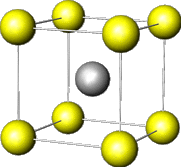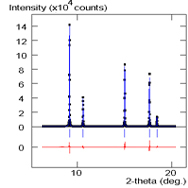

 |
 |
|
See recent activity here.
Au-Cd alloys are typical system, which shows martensitic transformation. Two martensites are reported, one is called g2' and other is z2'. g2f martensite was determined to be B19 type crystal structure and refined using single crystal [1]. On the other hand, concerning z2f martensite, the crystal structure was not determined more than fifty years, though several models reported since the discovery. The crystal structure of z2f [2] was determined by use of a single crystal ofz2f martensite. Related structural work is R phase in TiNi alloy [3].
The phonon behavior of martensitic materials attracts researchers from the viewpoint of transformation mechanism. After structure determination of Au-Cd martensite, the phonon behavior was next target of the research. The neutron inelastic scattering experiment is the best way of observing the phonon behavior. However, Cd is a strong absorber of neutron and unable to observe the phonon behavior. Ohba et al. utilized an isotope of Cd for growing a single crystal of AuCd and succeeded in measuring the phonon dispersion [4][5] at Brookhaven National Laboratory in U.S. with help of Professor Shapiro. Related precursor phenomena of the transformation were also studied and a few of them are listed in references [6][7][10].
The rubber-like behavior is an interesting phenomenon shown by AuCd. Although the phenomenon looks similar to super-elasticity, the mechanism is completely different from that. The mechanism of super-elasticity is related to the phase transformation, but not of the erubber-likef. The mechanism of the 'rubber-like' has not been solved yet. Several models explaining the behavior have been proposed. Some of them proposed that the structure change of martensite caused the erubber-likef behavior. Ohba et al. reported that there is no structure change [8][9] in martensite and half of the models were denied and new stage of the research started.
@